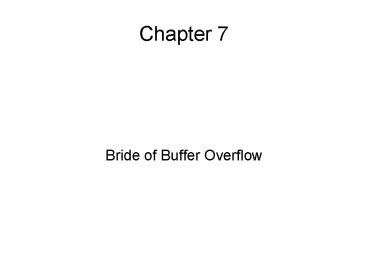Bride of Buffer Overflow - PowerPoint PPT Presentation
Title:
Bride of Buffer Overflow
Description:
Chapter 7 Bride of Buffer Overflow Chapter Synopsis Integers Wrap around errors Truncation and sign extension Conversions between unsigned and signed Methods to ... – PowerPoint PPT presentation
Number of Views:132
Avg rating:3.0/5.0
Title: Bride of Buffer Overflow
1
Chapter 7
- Bride of Buffer Overflow
2
Chapter Synopsis
- Integers
- Wrap around errors
- Truncation and sign extension
- Conversions between unsigned and signed
- Methods to detect and prevent problems
- Runtime Protection
- Safe Programming Lanuages
- Safer C Dialects
- Dynamic Buffer Overflow protections
3
The Problem
- Numbers in computers are not integers but only an
approximation. They are bounded, have a sign,
representation, etc. - Many arithmetic operations, many conversions have
a risk of returning non-sense values due to
machine limitations. - When this non-sense value is used for memory
allocation, bound a string operation or index
into a buffer, we have a buffer overflow.
4
The 4 bit number wheels
5
An example
- An Integer Overflow causing a Buffer overflow
u_int nresp
nresp packet_get_int()
if ( nresp gt 0 )
response xmalloc(nrespsizeof(char ))
for (i 0 i lt nresp i)
responsei
packet_get_string(NULL) - Value of nresp 1073741824 causes problems.
6
Other Problems
- Subtracting from 0 can also cause problems.
- (example, page 238)? (next slide)
7
Bad subtract from 0
- unsigned int readamt
- readamt getstringsize(...)
- if ( readamt gt 1024 ) return -1
- readamt-- // don't allocate space for '\n'
- buf malloc(readamt)
8
Truncation and sign extension
- When integers get truncated, the most significant
part is lost when they get expanded, the most
significant bit is extended, sometimes with
unexpected results. - Examples
- -1 truncated to 4 bits is 15
- 4 bit 7 expanded is still 7, but
- 4 bit 15 (unsigned) can become -1!
9
Conversion between signed and unsigned
- The problem is the high-order bit the semantics
are different, the meaning is different. Bad
example - char a
- short len ????
- if (len lt 1024 ) a malloc((int)len)
- .
- .
10
What to do?
- Use Unsigned types (watch out, though)?
- Expect bad assumptions
- Restrict numeric User input use santy checks
- Sanity check values used to allocate and access
memory - Respect compiler warnings.
- Use best practices for your compiler
- Understand Integer Conversion rules
- Verify overflow of operators
11
Use Best Practices for CL from MSDN
- Compile with highest possible warning level /W4
- Watch out for integer related compiler warnings
- Investigate all pragma disabling overflows
- Enable runtime integer error checks for
conversion overflows with /RTCc (for debugging
only)?
12
Use Best Practices for gcc
- Compile with -wconversion -wsign-compare
- Check all pragma disabling diagnostics.
- Enable runtime error checks with -ftrapv (not for
production runs)?
13
Understand Integer Conversion rules
- Plethora of rules but most important ones
- Less precision is usually upcast to higher
precision but - An unsigned type can be implicitly cast to a
signed type even if not all values can be
represented.
14
Verify conditions for operators that can overflow
15
Use Special Libraries
- SafeInt
- IntSafe
16
Safer Programming Languages/Dialects
- Safe Programming Languages like
- Java
- C
- Python
- Ruby
- Safe dialects of C/C like
- Ccured
- Cyclone
17
Dynamic Buffer Overflow Protections
- Not a fix
- Non-executable memory segments
- Compile-Time Instrumentation (canaries)?
- Virtual Execution Environments
- Hardened System Libraries































